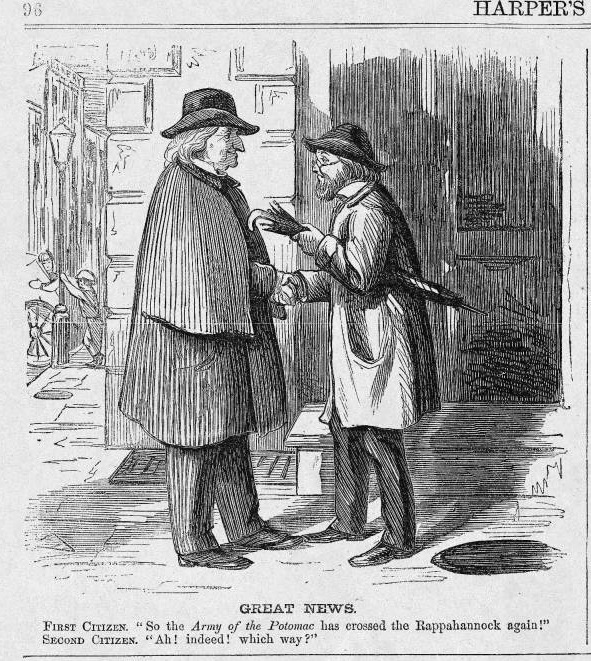"Great News"
By Joseph Scoggins
By November of 1862 General Ambrose Burnside had been granted command of the Union Army in the Eastern Theater and was preparing for a new campaign across the Rappahannock River, this time planning to take Richmond after first securing the town of Fredericksburg.[1] The Confederacy, and seemingly fate, had other plans, however, and Burnside’s grand campaign ended in failure, turning the actions of the Army of the Potomac into, at best, a joke fit for the political cartoon.
Assuming command on November 7, 1862, General Burnside was forced to act quickly in order to satisfy President Abraham Lincoln and his cabinet, and by November 19 he had marched his army all the way to Falmouth, Virginia, from which he sought to attack Fredericksburg.[2] Unfortunately for Burnside, a combination of heavy rain and delayed supplies stalled his offensive, preventing him from quickly crossing the Rappahannock and taking Fredericksburg, as had been his aim. As a result, it was not until December 11, nearly three weeks after Burnside’s arrival at Falmouth, that the crossing of the Rappahannock would occur, thus beginning the Battle of Fredericksburg. However, this three-week interlude had given the Confederate Army, which had arrived at Fredericksburg on November 20, more than adequate time to prepare. As a result, on December 15 the Army of the Potomac was forced to retreat, heading once more across the Rappahannock.[3]
This, however, was not the end of the Army of the Potomac’s woes. On January 20, 1863, the entire army was ordered to take up positions for the planned crossing of the Rappahannock scheduled for the following morning, thus beginning the disastrous “Mud March.”[4] After breaking camp, the army soon found itself quite literally bogged down in a fierce rain, significantly slowing their progress across swamped roads before ultimately being forced to abandon the offensive. The final result of this was that Lincoln ordered Burnside to be relieved of his command, and Burnside officially turned over his command to General Joseph Hooker on January 26.[5]
The defeat of the Union Army at the Battle of Fredericksburg, as well as the disastrous Mud March, lent themselves favorably to political cartoonists. The cartoon entitled “Great News” is evidence of this, as the two citizens greeting each other do so by lampooning the army’s recent misfortunes. Says the first citizen, “So the Army of the Potomac has crossed the Rappahannock again!,” provoking the second citizen to quip, “Ah! indeed! which way?”[6]
Harper’s Weekly published “Great News” on February 7, 1863, in the same edition as the announcement that General Hooker had assumed command over the Army of the Potomac on January 26. Doubtless these articles were published at the same time so as to provide a parting shot at Burnside. However, the fact that the cartoon makes no mention of Burnside whatsoever indicates that there is a deeper element of dissatisfaction here that should also be considered.
Though the defeat at Fredericksburg was demoralizing to the army itself, this effect was not limited to just the army. Instead, the usage of ordinary citizens in the cartoon suggests that the Union public was close to having had enough of the delays and losses and that the Battle of Fredericksburg had taken a dramatic toll upon the fighting spirit of the Union public itself. In choosing to publish this cartoon, Harper’s Weekly acknowledged what was, at the time, an unhappy fact concerning the Eastern Theater: the winter offensive, initiated in 1862, had failed, and a solution needed to be found quickly before public sentiment dipped so low that future offensives would be deemed impossible to initiate. Hence the ironic title “Great News” in response to the Battle of Fredericksburg.
Endnotes:
[1] Francis O’Reilly, The Fredericksburg Campaign (Baton Rouge: Louisiana State University Press, 2003), 21.
[2] George Rable, Fredericksburg! Fredericksburg! (Chapel Hill: University of North Carolina Press, 2002), 43-80.
[3] Ibid, 287.
[4] Edward Stackpole, Drama on the Rappahannock (Harrisburg: Telegraph Press, 1987), 244.
[5] “The Army of the Potomac,” Harper’s Weekly, February 7, 1863.
[6] “Great News,” Harper’s Weekly, February 7, 1863.
Bibliography:
“The Army of the Potomac”, Harper’s Weekly, February 7, 1863.
“Great News”, Harper’s Weekly, February 7, 1863.
O’Reilly, Francis A. The Fredericksburg Campaign. Baton Rouge: Louisiana State University Press, 2003.
Rable, George C. Fredericksburg! Fredericksburg!. Chapel Hill: University of North Carolina Press, 2002.
Stackpole, Edward J. Drama on the Rappahannock. Harrisburg: Telegraph Press, 1987.
